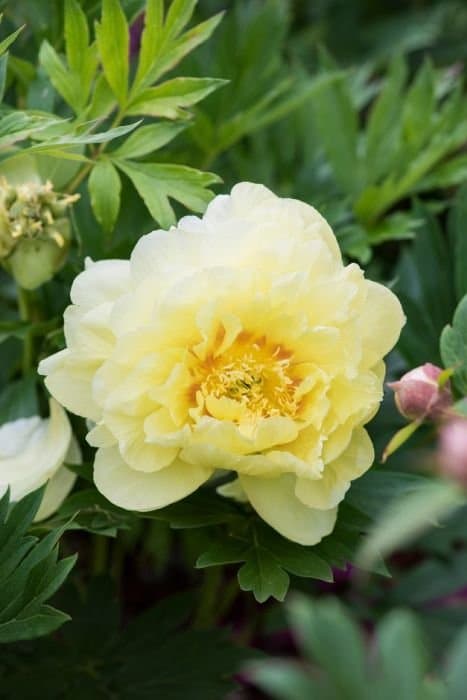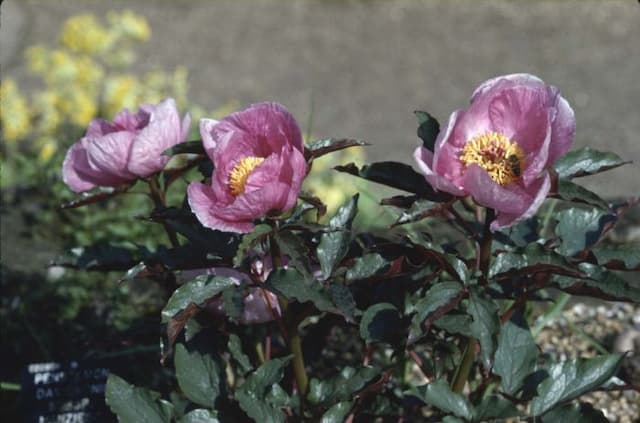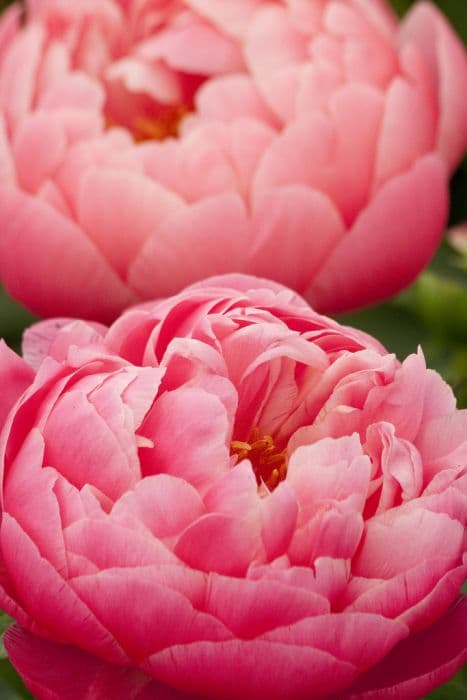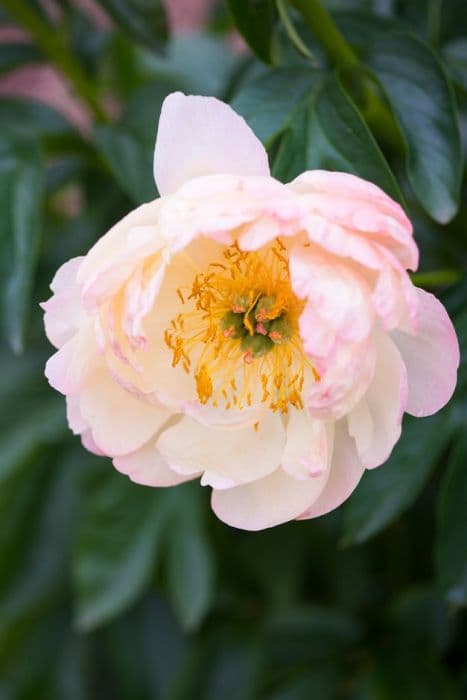Chinese Peony Paeonia lactiflora 'Vogue'

ABOUT
The 'Vogue' peony features large, lush blooms that are renowned for their striking beauty. The flowers exhibit a vivid pink color, drawing the eye with their bold yet elegant shades. Each flower is composed of numerous delicate, overlapping petals that are ruffled at the edges, creating a full and rounded appearance. As the plant matures, the blossoms showcase a gradient of pink hues, with the outer petals sometimes being a lighter pink that fades to a deeper tone toward the center. The center of the blossom is often punctuated with a cluster of golden-yellow stamens, which add a contrasting pop of color and visual interest. The foliage of the 'Vogue' peony is equally attractive, with glossy, dark green leaves that provide a lush backdrop for the showy flowers. The leaves are deeply lobed, contributing a rich texture to the overall presentation of the plant. Despite its impressive floral display, the 'Vogue' peony maintains a graceful and sturdy demeanor, with the flowers held aloft on strong stems. The plant is a perennial favorite in gardens and landscapes, cherished for its ornamental value and the classical beauty it brings to any setting. Its captivating blooms are not only a favorite for garden admirers but are also highly sought after for use in floral arrangements and bouquets, where they add a touch of timeless elegance.
About this plant
 Names
NamesFamily
Paeoniaceae
Synonyms
Chinese Peony, White Peony, Common Garden Peony
Common names
Paeonia lactiflora 'Vogue'.
 Toxicity
ToxicityTo humans
Peony (Paeonia lactiflora 'Vogue') is generally considered non-toxic to humans. However, if ingested in large quantities, some individuals might experience mild gastrointestinal discomfort, including nausea, vomiting, or diarrhea. Handling the plant could potentially cause skin irritation in sensitive individuals. It is always best to avoid ingesting any part of ornamental plants as a precaution.
To pets
Peony (Paeonia lactiflora 'Vogue') is considered mildly toxic to pets, including cats and dogs. If a pet ingests peony, they might experience symptoms such as vomiting, diarrhea, or drooling. While it is not typically life-threatening, ingesting this plant could cause your pet discomfort and possible complications if they have a sensitivity or an allergic reaction. If you suspect your pet has consumed parts of a peony plant, it is advisable to consult with a veterinarian.
 Characteristics
CharacteristicsLife cycle
Perennials
Foliage type
Deciduous
Color of leaves
Green
Flower color
Pink
Height
2-3 feet (60-90 cm)
Spread
2-3 feet (60-90 cm)
Plant type
Herb
Hardiness zones
3-8
Native area
Asia
Benefits
 General Benefits
General Benefits- Ornamental Value: Paeonia lactiflora 'Vogue', commonly known as Chinese Peony, has striking blooms that add aesthetic appeal to gardens and landscapes.
- Longevity: Chinese Peonies are perennial plants, which means they can live and bloom for many years when provided with the right conditions.
- Seasonal Interest: Chinese Peonies provide a burst of color in spring to early summer, enhancing the seasonal interest in gardens and outdoor areas.
- Attracts Pollinators: The large and colorful flowers of Chinese Peonies are effective in attracting bees and other pollinators, supporting local ecosystems.
- Cut Flower Use: Chinese Peonies make excellent cut flowers due to their large, showy blooms and long vase life, perfect for floral arrangements and bouquets.
- Drought Tolerance: Once established, Chinese Peonies exhibit a degree of drought tolerance, making them suitable for gardens with less frequent watering.
- Cold Hardy: These plants are capable of withstanding cold winter temperatures, making them suitable for a range of climates and extending their potential growing regions.
 Medical Properties
Medical Properties- Anti-inflammatory: Used traditionally to reduce inflammation.
- Antioxidant: Contains compounds that are believed to fight oxidative stress.
- Immunomodulatory: May influence immune system function.
- Anxiolytic effects: Can have a calming effect, reducing anxiety in traditional uses.
- Analgesic: May help relieve pain when used in traditional medicine preparations.
- Antispasmodic: Could potentially reduce muscle spasms according to traditional medicine practices.
- Sedative: In some traditional medicines, it is used to promote relaxation and sleep.
 Air-purifying Qualities
Air-purifying QualitiesThis plant is not specifically known for air purifying qualities.
 Other Uses
Other Uses- Art and illustration: The Paeonia lactiflora, commonly known as the peony, can be a muse for artists and illustrators due to its lush, full blossoms and vibrant colors.
- Photography subject: Peonies, with their large, showy flowers are popular subjects for photographers looking to capture the intricate beauty of nature.
- Culinary garnish: Petals from peonies can be used to decorate cakes and desserts for an elegant touch of color and a suggestion of edible flowers.
- Floral water: The petals of the peony can be steeped in water to create a delicately scented floral water for use in homemade beauty products or room fresheners.
- Natural dye: The colorful petals of peonies can be used to create natural dyes for fabric or paper, offering a range of pinks and reds.
- Scented sachets: Dried peony petals can be placed in small fabric sachets to create a pleasantly scented drawer or closet freshener.
- Wedding décor: Due to their lush appearance and association with romance, peonies are frequently used in wedding bouquets and venue decorations.
- Symbolic gift: In many cultures, peonies symbolize good fortune, happy marriage, and prosperity, making them a thoughtful gift.
- Eco-friendly confetti: Dried peony petals can serve as biodegradable confetti for celebrations, reducing the environmental impact of traditional plastic confetti.
- Crafting pressed flowers: The robust petals of peonies are ideal for pressing and using in crafts such as homemade cards, bookmarks, or framed botanical art.
Interesting Facts
 Feng Shui
Feng ShuiThe Peony is used in Feng Shui practice as a symbol of wealth, prosperity, and good fortune. Place it in the southwest corner of your garden or home to enhance love and romance or in the wealth corner to attract abundance.
 Zodiac Sign Compitability
Zodiac Sign CompitabilityThe Peony is not used in astrology practice.
 Plant Symbolism
Plant Symbolism- Prosperity and Wealth: Paeonia lactiflora, commonly known as peony, is often associated with richness and opulence, symbolizing economic success and the ambition for a prosperous life.
- Romance and Love: Peonies are traditionally linked to romantic love, regarded as an omen of good fortune for marriages, and are symbols of love's many forms, including the love between partners and within families.
- Beauty: With its full, ruffled blooms, the peony encapsulates the concept of beauty in its most classic and timeless form, symbolizing the ideal of feminine allure and traditional beauty standards.
- Honor and High Status: In many cultures, peonies are considered a symbol of honor and nobility, often associated with high social status and the respect that accompanies it.
- Healing and Good Health: In some traditions, peonies are thought to possess medicinal properties, representing the healing of the body and the wish for a healthy life.
 Water
WaterThe common garden peony, Paeonia lactiflora 'Vogue', should be watered deeply once a week, providing about one inch of water each time. It’s crucial to allow the soil to dry out between waterings to prevent root rot. During the growing season, this amounts to approximately 0.623 gallons per square foot per week. However, in hot and dry conditions, you may need to water it twice a week, ensuring the plant receives enough moisture. Always avoid overhead watering to minimize the risk of fungal diseases, and instead water at the base of the plant.
 Light
LightPeonies, including Paeonia lactiflora 'Vogue', thrive best in full sun to light shade. They should receive at least six hours of sunlight each day, ideally in the morning with some afternoon shade to protect the flowers from intense midday heat. A spot in the garden that has bright, indirect light during the hottest part of the day is ideal to prevent the blooms from fading too quickly.
 Temperature
TemperatureFor the garden peony or Paeonia lactiflora 'Vogue', the best temperature range for optimal growth is between 65 and 75 degrees Fahrenheit. They can survive winter temperatures as low as -20 degrees Fahrenheit. Hot climates can be a challenge for peonies; they usually don’t do well in environments where temperatures consistently exceed 80 degrees Fahrenheit, as they require a period of winter chill to bloom.
 Pruning
PruningPruning garden peonies like Paeonia lactiflora 'Vogue' is important to remove spent flowers and to keep the plant healthy. Deadheading after blooms fade encourages new growth and prevents the plant from wasting energy on seed production. Additionally, in the fall, typically after the first frost, cut back the foliage to the ground to help prevent overwintering diseases. Pruning is only required once per year after the blooming season or in fall for maintenance.
 Cleaning
CleaningAs needed
 Soil
SoilThe best soil mix for Peony 'Vogue' should be well-drained, fertile, and loamy with a pH of 6.5 to 7.0. Incorporate organic matter like compost and a balanced fertilizer before planting, and ensure adequate drainage to prevent root rot.
 Repotting
RepottingPeonies like 'Vogue' do not need to be repotted often; they prefer to be undisturbed and can remain in the same location for many years. Only consider repotting if the plant has outgrown its space or soil nutrients are depleted.
 Humidity & Misting
Humidity & MistingPeony 'Vogue' is tolerant of average outdoor humidity levels and does not require specific humidity conditions for growth. Avoid excessive humidity to prevent fungal diseases.
 Suitable locations
Suitable locationsIndoor
Provide bright light, cool temperatures, and plant in well-draining soil.
Outdoor
Plant in full sun to partial shade and ensure well-draining, fertile soil.
Hardiness zone
3-8 USDA
 Life cycle
Life cycleThe life cycle of Paeonia lactiflora 'Vogue', commonly known as the Chinese Peony or White Peony, begins with seed germination, which, depending on environmental conditions, can take several months to a year. After germination, the seedling develops a primary root system and a shoot that emerges above the soil, growing into a small plant with few leaves. In subsequent years, the plant establishes a larger root system and more foliage, typically taking 2-3 years to mature sufficiently to bloom. Full flowering typically occurs in late spring to early summer, when 'Vogue' produces large, fragrant white flowers. After blooming, the plant stores energy in its underground tuberous roots as the foliage begins to yellow and die back in late summer to fall. In winter, the plant enters dormancy, surviving underground until the next spring when the cycle begins anew with the emergence of new shoots.
 Propogation
PropogationPropogation time
Spring to Summer
Propogation: Paeonia lactiflora 'Vogue', commonly known as the Chinese peony, is best propagated in the fall after the plants have gone dormant. The most popular method of propagation for this perennial is through division. To propagate by division, you should carefully dig up the root ball of an established plant. Using a sharp knife, divide the root clump into sections, ensuring that each section has at least three to five eyes, which are the small reddish buds on the crown of the root. These eyes will become the next season's shoots. Replant the divisions promptly, setting them so the eyes are no more than 1 to 2 inches (approximately 2.5 to 5 centimeters) below the surface of the soil. Water thoroughly after planting to establish the new divisions. This method allows the clones to mature more quickly than starting from seed and usually results in a blooming plant in a few years.









